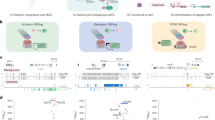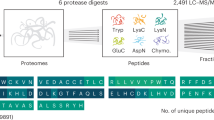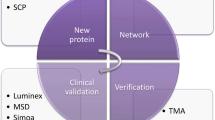Abstract
Proteomics, the large-scale analysis of proteins, will contribute greatly to our understanding of gene function in the post-genomic era. Proteomics can be divided into three main areas: (1) protein micro-characterization for large-scale identification of proteins and their post-translational modifications; (2) ‘differential display’ proteomics for comparison of protein levels with potential application in a wide range of diseases; and (3) studies of protein–protein interactions using techniques such as mass spectrometry or the yeast two-hybrid system. Because it is often difficult to predict the function of a protein based on homology to other proteins or even their three-dimensional structure, determination of components of a protein complex or of a cellular structure is central in functional analysis. This aspect of proteomic studies is perhaps the area of greatest promise. After the revolution in molecular biology exemplified by the ease of cloning by DNA methods, proteomics will add to our understanding of the biochemistry of proteins, processes and pathways for years to come.
This is a preview of subscription content, access via your institution
Access options
Subscribe to this journal
Receive 51 print issues and online access
$199.00 per year
only $3.90 per issue
Buy this article
- Purchase on SpringerLink
- Instant access to full article PDF
Prices may be subject to local taxes which are calculated during checkout







Similar content being viewed by others
References
Wilkins, M. R., Williams, K. L., Apple, R. D. & Hochstrasser, D. F. Proteome Research: New Frontiers in Functional Genomics 1– 243 (Springer, Berlin, 1997).
Wilkins, M. R. et al. From proteins to proteomes: large scale protein identification by two-dimensional electrophoresis and amino acid analysis. BioTechnology 14, 61–65 ( 1996).
Celis, J. et al. Human 2-D PAGE databases for proteome analysis in health and disease: http://biobase.dk/cgi-bin/celis. FEBS Lett. 398, 129–134 ( 1996).
Anderson, N. G. & Anderson, N. L. Twenty years of two-dimensional electrophoresis: past, present and future. Electrophoresis 17, 443–453 (1996).
O'Farrell, P. H. High resolution two-dimensional electrophoresis of proteins. J. Biol. Chem. 250, 4007–4021 (1975).
Burley, S. K. et al. Structural genomics: beyond the human genome project. Nature Genet. 23, 151–157 (1999).
Krogh, A. in Guide to Human Genome Computing (ed. Bishop, M. J.) 261– 274 (Academic, San Diego, 1998).
Dunham, I. et al. The DNA sequence of human chromosome 22. Nature 402, 489–495 (1999).
Claverie, J. M. Computational methods for the identification of genes in vertebrate genomic sequences. Hum. Mol. Genet. 6, 1735– 1744 (1997).
Pandey, A. & Lewitter, F. Nucleotide sequence databases: a gold mine for biologists. Trends Biochem. Sci. 24 , 276–280 (1999).
Brenner, S. E. Errors in genome annotation. Trends Genet. 15, 132–133 (1999).
Gygi, S., Rochon, Y., Franza, B. R. & Aebersold, R. Correlation between protein and mRNA abundance in yeast. Mol. Cell. Biol. 19, 1720–1730 ( 1999).
Futcher, B. et al. A sampling of the yeast proteome. Mol. Cell. Biol. 19, 7357–7368 ( 1999).
Pandey, A., Andersen, J. S., & Mann, M. Use of mass spectrometry to study signaling pathways . Science's STKE (in the press).
Henzel, W. J., Billeci, T. M., Stults, J. T. & Wong, S. C. Identifying proteins from two-dimensional gels by molecular mass searching of peptide fragments in protein sequence databases. Proc. Natl Acad. Sci. USA 90, 5011–5015 (1993).
Jensen, O. N., Mortensen, P., Vorm, O. & Mann, M. Automation of matrix assisted laser desorption/ionization mass spectrometry using fuzzy logic feedback control. Anal. Chem. 69, 1706– 1714 (1997).
Berndt, P., Hobohm, U. & Langen, H. Reliable automatic protein identification from matrix-assisted laser desorption/ionization mass spectrometric peptide fingerprints. Electrophoresis 20, 3521–3526 (1999).
Shevchenko, A. et al. Linking genome and proteome by mass spectrometry: large scale identification of yeast proteins from two dimensional gels. Proc. Natl Acad. Sci. USA 93, 14440–14445 (1996).
Shevchenko, A. et al. MALDI quadruple time-of-flight mass spectrometry: powerful tool for proteomic research. Anal. Chem. 72, 2132–2141 (2000).
Zhang, B., Liu, H., Karger, B. L. & Foret, F. Microfabricated devices for capillary electrophoresis-electrospray mass spectrometry. Anal. Chem. 71, 3258–3264 (1999).
Figeys, D., Gygi, S. P., McKinnon, G. & Aebersold, R. An integrated microfluidics-tandem mass spectrometry system for automated protein analysis. Anal. Chem. 70, 3728– 3734 (1998).
Li, J. et al. Integration of microfabricated devices to capillary electrophoresis—electrospray mass spectrometry using a low dead volume connection: application to rapid analyses of proteolytic digests. Anal. Chem. 71, 3036–3045 (1999).
Eckerkorn, C. et al. Mass spectrometric analysis of blotted proteins after gel electrophoresis separation by matrix-assisted laser desorption/ionization . Electrophoresis 13, 664– 665 (1992).
Strupat, K. et al. Matrix-assisted laser desorption ionization mass spectrometry of proteins electroblotted after polyacrylamide gel electrophoresis. Anal. Chem. 66, 464–470 (1994).
Bienvenut, W. V. et al. Toward a clinical molecular scanner for proteome research: parallel protein chemical processing before and during western blot. Anal. Chem. 71, 4800–4807 (1999).
Binz, P. A. et al. A molecular scanner to automate proteomic research and to display proteome images. Anal. Chem. 71, 4981–4988 (1999).
Jensen, P. K. et al. Probing proteomes using capillary isoelectric focusing-electrospray ionization Fourier transform ion cyclotron resonance mass spectrometry. Anal. Chem. 71, 2076–2084 (1999).
Mørtz, E. et al. Sequence tag identification of intact proteins by matching tandem mass spectral data against sequence data bases. Proc. Natl. Acad. Sci. USA 93, 8264–8267 (1996).
Li, W., Hendrickson, C. L., Emmett, M. R. & Marshall, A. G. Identification of intact proteins in mixtures by alternated capillary liquid chromatography electrospray ionization and LC ESI infrared multiphoton dissociation Fourier transform ion cyclotron resonance mass spectrometry. Anal. Chem. 71, 4397–4402 ( 1999).
Nuwaysir, L. & Stults, J. T. ESI mass spectrometry of phosphopeptides isolated by on-line immobilized metal affinity chromatography. J. Am. Soc. Mass Spectrom. 4, 662– 669 (1993).
Betts, J. C., Blackstock, W. P., Ward, M. A. & Anderton, B. H. Identification of phosphorylation sites on neurofilament proteins by nanoelectrospray mass spectrometry. J. Biol. Chem. 272, 12922 –12927 (1997).
Neubauer, G. & Mann, M. Mapping of phosphorylation sites of gel-isolated proteins by nanoelectrospray tandem mass spectrometry: potentials and limitations. Anal. Chem. 71, 235– 242 (1999).
Zhang, X. et al. Identification of phosphorylation sites in proteins separated by polyacrylamide gel electrophoresis. Anal. Chem. 70, 2050–2059 (1998).
Cortez, D., Wang, Y., Qin, J. & Elledge, S. J. Requirement of ATM-dependent phosphorylation of brca1 in the DNA damage response to double-strand breaks. Science 286, 1162– 1166 (1999).
Soskic, V. et al. Functional proteomics analysis of signal transduction pathways of the platelet-derived growth factor beta receptor. Biochemistry 38, 1757–1764 ( 1999).
Pandey, A. et al. Analysis of receptor signaling pathways by mass spectrometry: identification of Vav-2 as a substrate of the epidermal and platelet-derived growth factor receptors. Proc. Natl Acad. Sci. USA 97, 179–184 (2000).
DeRisis, J., Iyer, V. R. & Brown, O. P. Exploring the metabolic and genetic control of gene expression on a genomic scale. Science 278, 680–686 (1997).
Golub, T. R. et al. Molecular classification of cancer: class discovery and class prediction by gene expression monitoring. Science 286 , 531–537 (1999).
Roberts, C. J. et al. Signaling and circuitry of multiple MAPK pathways revealed by a matrix of global gene expression profiles. Science 287, 873–880 (2000).
Alizadeh, A. A. et al. Distinct types of diffuse large B-cell lymphoma identified by gene expression profiling. Nature 403, 503–511 (2000).
Ostergaard, M., Wolf, H., Orntoft, T. F. & Celis, J. E. Psoriasin (S100A7): a putative urinary marker for the follow-up of patients with bladder squamous cell carcinomas. Electrophoresis 20, 349 –354 (1999).
Page, M. J. et al. Proteomic definition of normal human luminal and myoepithelial breast cells purified from reduction mammoplasties. Proc. Natl Acad. Sci. USA 96, 12589–12594 (1999).
Gauss, C. et al. Analysis of the mouse proteome. (I) Brain proteins: separation by two-dimensional electrophoresis and identification by mass spectrometry and genetic variation. Electrophoresis 20, 575–600 (1999).
Aicher, L. et al. New insights into cyclosporine A nephrotoxicity by proteome analysis. Electrophoresis 19, 1998– 2003 (1998).
Celis, J. E. et al. A comprehensive protein resource for the study of bladder cancer: http://biobase.dk/cgi-bin/celis. Electrophoresis 20, 300–309 ( 1999).
Breitenbach, M. et al. Biological and immunological importance of Bet v 1 isoforms . Adv. Exp. Med. Biol. 409, 117– 126 (1996).
Sander, I. et al. Allergy to aspergillus-derived enzymes in the baking industry: identification of beta-xylosidase from aspergillus niger as a new allergen (Asp n 14). J. Allergy Clin. Immunol. 102, 256–264 (1998).
Lueking, A., Horn, M., Eickhoff, H., Lehrach, H. & Walter, G. Protein microarrays for gene expression and antibody screening. Anal. Biochem. 270, 103– 111 (1999).
Davies, H., Lomas, L. & Austen, B. Profiling of amyloid beta peptide variants using SELDI Protein Chip arrays. Biotechniques 27, 1258 –1261 (1999).
Nelson, R. W. The use of bioreactive probes in protein characterization. Mass Spectrom. Rev. 16, 353–376 (1997).
Gygi, S. P. et al. Quantitative analysis of complex protein mixtures using isotope-coded affinity tags. Nature Biotechnol. 17, 994 –999 (1999).
Neubauer, G. et al. Identification of the proteins of the yeast U1 small nuclear ribonucleoprotein complex by mass spectrometry. Proc. Natl Acad. Sci. USA 94, 385–390 ( 1997).
Lamond, A. I. & Mann, M. Cell biology and the genome projects—a concerted strategy for characterizing multi-protein complexes using mass spectrometry . Trends Cell Biol. 7, 139– 142 (1997).
Link, A. J. et al. Direct analysis of protein complexes using mass spectrometry . Nature Biotechnol. 17, 676– 682 (1999).
Blackstock, W. P. & Weir, M. P. Proteomics: quantitative and physical mapping of cellular proteins. Trends Biotechnol. 17, 121–127 (1999).
Strausberg, R. L., Feingold, E. A., Klausner, R. D. & Collins, F. S. The mammalian gene collection. Science 286, 455–457 (1999).
Neubauer, G. et al. Mass spectrometry and EST-database searching allows characterization of the multi-protein spliceosome complex. Nature Genet. 20, 46–50 (1998).
Winter, D., Podtelejnikiov, A. V., Mann, M. & Li, R. The complex containing actin-related proteins Arp2 and Arp3 is required for the motility and integrity of yeast actin patches. Curr. Biol. 7, 519–529 (1997).
Rout, M. P. et al. The yeast nuclear pore complex: composition, architecture, and transport mechanism. J. Cell. Biol. 148, 635–651 (2000).
Houry, W. A. et al. Identification of in vivo substrates of the chaperonin GroEL . Nature 402, 147–154 (1999).
Witke, W. et al. In mouse brain profilin I and profilin II associate with regulators of the endocytic pathway and actin assembly. EMBO J. 17, 967–976 (1998).
Shevchenko, A. & Mann, M. in Mass Spectrometry in Biology and Medicine (eds Burlingame, A., Carr, C. A. & Baldwin, M. A.) 237–269 (Humana, Totowa, 1999).
Rigaut, G. et al. A generic protein purification method for protein complex characterization and proteome exploration. Nature Biotechnol. 17, 1030–1032 (1999).
Rappsilber, J., Siniossoglou, S., Hurt, E. C. & Mann, M. A generic strategy to analyze the spatial organization of multi-protein complexes by cross-linking and mass spectrometry. Anal. Chem. 72, 267–275 (2000).
Rowley, A. et al. Applications of protein mass spectrometry in cell biology . Methods 20, 383–397 (2000).
Peltier, J. B. et al. Proteomics of the chloroplast. Systematic identification and targeting analysis of lumenal and peripheral thylakoid proteins. Plant Cell 12, 319–342 ( 2000).
Mintz, P. J. et al. Purification and biochemical characterization of interchromatin granule clusters. EMBO J. 18, 4308– 4320 (1999).
Fields, S. & Song, O. K. A novel genetic system to detect protein–protein interactions. Nature 340, 245–246 (1989).
Walhout, A. J. et al. Protein interaction mapping in C. elegans using proteins involved in vulval development. Science 287, 116–122 (2000).
Uetz, P. et al. A comprehensive analysis of protein–protein interactions in Saccharomyces cerevisiae. Nature 403, 623–627 (2000).
Ito, T. et al. Toward a protein–protein interaction map of the budding yeast: a comprehensive system to examine two-hybrid interactions in all possible combinations between the yeast proteins. Proc. Natl Acad. Sci. USA 97, 1143–1147 ( 2000).
Vidal, M. & Endoh, H. Prospects for drug screening using the reverse two-hybrid system. Trends Biotechnol. 17 , 374–381 (1999).
Zozulya, S. et al. Mapping signal transduction pathways by phage display. Nature Biotechnol. 17, 1193–1198 (1999).
Hufton, S. E. et al. Phage display of cDNA repertoires: the pVI display system and its applications for the selection of immunogenic ligands. J. Immunol. Methods 231, 39–51 (1999).
Martzen, M. R. et al. A biochemical genomics approach for identifying genes by the activity of their products. Science 286, 1153–1155 (1999).
Zambrowicz, B. P. et al. Disruption and sequence identification of 2,000 genes in mouse embryonic stem cells. Nature 392, 608– 611 (1998).
Fire, A. et al. Potent and specific genetic interference by double-stranded RNA in Caenorhabditis elegans. Nature 391, 806–811 (1998).
Winzeler, E. A. et al. Functional characterization of the S. cerevisiae genome by gene deletion and parallel analysis. Science 285 , 901–906 (1999).
Mattheakis, L. C., Bhatt, R. R. & Dower, W. J. An in vitro polysome display system for identifying ligands from very large peptide libraries. Proc. Natl Acad. Sci. USA 91, 9022–9026 ( 1994).
Roberts, R. W. & Szostak, J. W. RNA-peptide fusions for the in vitro selection of peptides and proteins. Proc. Natl Acad. Sci. USA 94, 12297–12302 (1997).
Wilm, M. & Mann, M. Analytical properties of the nanoelectrospray ion source. Anal. Chem. 68, 1– 8 (1996).
Wilm, M. et al. Femtomole sequencing of proteins from polyacrylamide gels by nano electrospray mass spectrometry. Nature 379, 466–469 (1996).
Roepstorff, P. & Fohlman, J. Proposed nomenclature for sequence ions. Biomed. Mass Spectrom. 11, 601 (1984).
Yates, J. R. Mass spectrometry. From genomics to proteomics. Trends Genet. 16, 5–8 (2000).
Mann, M. & Wilm, M. S. Error tolerant identification of peptides in sequence databases by peptide sequence tags. Anal. Chem. 66, 4390–4399 ( 1994).
Mann, M. A shortcut to interesting human genes: peptide sequence tags, ESTs and computers . Trends Biochem. Sci. 21, 494– 495 (1996).
Eng, J. K., McCormack, A. L. & J. R. Yates, I. An approach to correlate MS/MS data to amino acid sequences in a protein database. J. Am. Soc. Mass Spectrom. 5, 976–989 ( 1994).
Yates, J. R. III Database searching using mass spectrometry data. Electrophoresis 19, 893–900 (1998).
Acknowledgements
We thank B. Blagoev and M. Fernandez for their expert assistance with cell culture and immunoprecipitation experiments. We thank all other members of the Protein Interaction Laboratory for valuable discussions and comments on the manuscript and A. King, Protana A/S, for obtaining the data for the new spliceosomal protein. O. N. Jensen and A. Stensballe are acknowledged for their contributions in the analysis of phosphopeptides. A.P. was supported by the Howard Temin Award from the National Cancer Institute. This work was funded in part by a grant from the Danish National Research Foundation to M.M.'s laboratory (http://www.pil.sdu.dk) at the Center for Experimental BioInformatics (CEBI).
Author information
Authors and Affiliations
Corresponding author
Rights and permissions
About this article
Cite this article
Pandey, A., Mann, M. Proteomics to study genes and genomes. Nature 405, 837–846 (2000). https://doi.org/10.1038/35015709
Issue Date:
DOI: https://doi.org/10.1038/35015709



